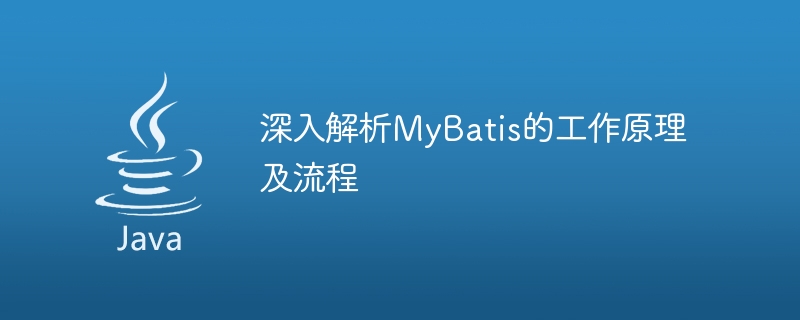

In-depth analysis of the working principle and process of MyBatis
MyBatis is a popular persistence layer framework used to simplify the interaction process with the database. It provides a flexible mapping mechanism that can map SQL statements to Java objects, and supports transaction management and caching mechanisms. This article will deeply analyze the working principle and process of MyBatis, and illustrate it through specific code examples.
1. The working principle of MyBatis
The working principle of MyBatis can be simply divided into two stages: the configuration stage and the running stage.
In the configuration phase, MyBatis will read the configuration file (such as mybatis-config.xml) and mapping file (such as UserMapper.xml), and parse they. The configuration file contains configuration items such as database connection information, global settings, and type processors, while the mapping file defines the mapping relationship between SQL statements and Java methods.
In the running phase, MyBatis first creates a SqlSessionFactory object based on the parsing results of the configuration phase, which is responsible for creating SqlSession instances. SqlSession is the core object for interacting with the database, through which we can execute SQL statements and obtain results.
2. The workflow of MyBatis
The workflow of MyBatis can be simply described as the following steps:
First, MyBatis will load the configuration file (mybatis-config.xml). This file contains configuration items such as database connection information, global settings, and the path to the mapping file. When loading the configuration file, MyBatis will create a Configuration object, which saves all configuration information.
Next, MyBatis will parse the mapping file (such as UserMapper.xml). The mapping file defines the mapping relationship between SQL statements and Java methods. MyBatis will parse the mapping file into MappedStatement objects, and each MappedStatement object represents the mapping relationship of a SQL statement.
According to the parsing results of the configuration phase, MyBatis will create a SqlSessionFactory object. SqlSessionFactory is one of the core interfaces of MyBatis, which is responsible for creating SqlSession objects.
Next, we need to create a SqlSession object using the SqlSessionFactory object. SqlSession is the core interface for MyBatis to interact with the database. It can execute SQL statements and return execution results. After using the SqlSession, you need to close it manually.
Code example:
String resource = "mybatis-config.xml";
InputStream inputStream = Resources.getResourceAsStream(resource);
SqlSessionFactory sqlSessionFactory = new SqlSessionFactoryBuilder().build(inputStream);
SqlSession sqlSession = sqlSessionFactory.openSession();
try {
// 调用SqlSession的方法执行SQL语句
// ...
} finally {
sqlSession.close();
}After obtaining the SqlSession object, we can execute the SQL statement through it. MyBatis provides a variety of ways to execute SQL statements, including selectOne, selectList, insert, update and delete methods. We only need to pass in the mapping ID and corresponding parameters corresponding to the SQL statement to execute the SQL statement and obtain the results.
Code example:
User user = sqlSession.selectOne("com.example.UserMapper.getUserById", 1);
System.out.println(user);If we enable transactions when executing SQL statements, then after all SQL statements are executed, The transaction needs to be committed manually.
Code example:
sqlSession.commit();
Finally, after using SqlSession, you need to manually close it and release resources.
Code example:
sqlSession.close();
3. Summary
This article provides an in-depth analysis of the working principle and process of MyBatis. The configuration phase mainly reads configuration files and parses mapping files, while the running phase creates SqlSessionFactory objects, through which SqlSession is created and SQL statements are executed. Through specific code examples, we can better understand the workflow of MyBatis and learn how to use it to simplify the interaction process with the database. I hope this article will help everyone understand MyBatis.
The above is the detailed content of In-depth exploration of the operating mechanism and execution process of MyBatis. For more information, please follow other related articles on the PHP Chinese website!
 mybatis first level cache and second level cache
mybatis first level cache and second level cache
 SQL statement to backup database
SQL statement to backup database
 How does a switch work?
How does a switch work?
 What is the difference between ibatis and mybatis
What is the difference between ibatis and mybatis
 How to configure database connection in mybatis
How to configure database connection in mybatis
 What is the working principle and process of mybatis
What is the working principle and process of mybatis
 What are the differences between hibernate and mybatis
What are the differences between hibernate and mybatis
 Common methods in Math class
Common methods in Math class




